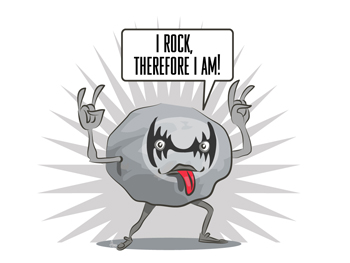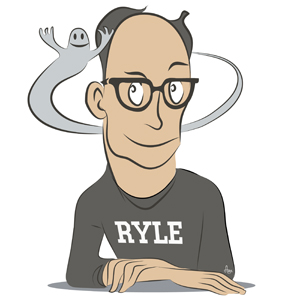
Your complimentary articles
You’ve read one of your four complimentary articles for this month.
You can read four articles free per month. To have complete access to the thousands of philosophy articles on this site, please
Rebel Realities
The Private Lives Of Rocks
Jon David thinks about the view that everything has awareness.
Do rocks have minds? A minority of modern philosophers are prepared (but only, perhaps, after some prodding) to admit they believe the answer is ‘yes’ – or at least, ‘sort of’. In the past decade, a number of bona fide academics, such as Australia’s Freya Mathews, the USA’s David Skrbina, and the UK’s Galen Strawson, have emerged as champions of panpsychism: the view that not only rocks, but everything in the universe is – in some sense, and to some extent – conscious.
The Roots of Universal Consciousness
The idea that inanimate objects have some kind of consciousness isn’t entirely new. Alfred North Whitehead promoted it early in the Twentieth Century. Going even further back, early societies apparently believed that the natural world is populated by intelligent spirits who could control the environment – think of the naiads and driads of Greek myth, for example.

By the historical period, such animism was on the wane – but it wasn’t dead. In the Sixth Century BCE, the earliest recorded Greek philosopher, Thales, famously wrote “All things are full of gods.” Aristotle reported that Thales said this because he noticed that a certain kind of rock, lodestone, has a mysterious power of attracting iron. So individual gods dwelt in the individual lodestones, and were able to reach out and drag iron nails towards them. If such spirits lived in magnetic rocks, Thales reasoned, why shouldn’t they also inhabit other objects?
It didn’t stop with Thales. Plato, writing in the Fourth Century BCE, believed that the universe as a whole was a conscious, living entity, with an anima mundi or ‘world soul’ (anima is Latin for ‘soul’, and later writers used it to translate the Greek word Plato used, psyche, which can mean either ‘soul’ or ‘mind’). Plato’s mystically-inclined later followers, the Neoplatonists, went even further. In the third century CE, one of them, Plotinus, claimed to have experienced union with the anima mundi through ecstatic meditation. Another Neoplatonist, Iamblichus, believed not only that the universe was conscious, but that it was packed with spirits along the lines of The Tempest’s Ariel, who could, through appropriate rites, be called upon to do our bidding – including by animating (literally ‘ensouling’) stone statues.
The Christian church tried to stamp out such flagrant paganism, but it was never entirely successful, and by the Sixteenth Century the Renaissance’s interest in ancient spirituality was all over Europe. For instance, the alchemist Paracelsus, along with originating the bacterial theory of disease, believed that the elements of earth, air, fire and water each had animating spirits, ‘elementals’, who could be invoked for magic rituals. In the case of earth – and for our purpose, rocks – the elementals are gnomes. Meanwhile, the Hermetic philosopher Giordano Bruno claimed “there is nothing that does not possess a soul.” Even the comparatively level-headed English natural philosopher William Gilbert, in his treatise On the Magnet (1600), argued that magnets had souls, and that compasses pointed north because they were attracted by the earth’s soul. Thales and Plato would have nodded approvingly.
The Matter with Modern Minds
But why would modern philosophers, raised on the type of view bequeathed by Newton that the universe is essentially a vast mechanism, ever flirt with the claim that inanimate objects are conscious? The answer is in the question. The universe-as-machine metaphor so beloved of early modern scientists implies that the universe has analysable working parts and that we can learn to predict its clock-like behaviour. But clocks do not, most would say, have minds. Yet the universe includes minds. We know it does, because we have some of them. But how can our minds possibly be related to the matter that makes up our machine-like bodies and the rest of this clockwork universe? How for example can my mind – not my brain, but my consciousness – move my hand just by thinking?
This problem has haunted philosophers for centuries. The Eighteenth Century Anglo-Irish bishop George Berkeley tried to exorcise it by abolishing the mysterious mind-matter relation through his audacious claim that there’s no such thing as matter. There are only minds, and ideas in minds. Allegedly material objects, such as rocks – or even brains – are really just ideas in the minds of perceivers looking at them, or in God’s mind, if there’s no one else looking [see elsewhere this issue for Berkeley, Ed]. But this mental-only solution to the problem of mind’s interaction with matter, called idealism, never caught on. Samuel Johnson certainly wasn’t impressed. “I refute it thus,” he said, kicking a pebble. In his eyes, he thought he could prove that the pebble was a chunk of matter by kicking it.
The Twentieth Century English philosopher Gilbert Ryle went in the opposite direction. He insisted there’s no such thing as mind, if by ‘mind’ we mean some separate ghostly entity that inhabits the body until death severs the connection. Mind, he claimed, is nothing more than the body’s disposition to react in certain ways to certain stimuli. There is no “ghost in the machine,” to use Ryle’s own phrase. But this solution, physicalism, is also hard to swallow. How could we think there’s no such thing as mind? What would we be thinking it with?
There’s also the question of where mind, or consciousness, came from. If the rest of the universe is unthinking, unfeeling matter, then what happened to give our ancestors their spark of awareness? Some people might be content to say that the fact mind and matter interact, and the fact there are minds at all in an otherwise material universe, are miracles, and leave it at that. But for atheists and agnostics, as well as believers who don’t want to sweep mysteries under the carpet, this won’t do.
The Panpsychic World
This is where panpsychism comes in. For if mind is matter in the form of brains, then equally, matter in the form of brains, is mind. But panpsychism doesn’t just restrict this thinking to brains. Why suppose there are two different kinds of matter in the universe, the insensate kind that makes up most things, and the special kind that somehow ends up in our heads? “I would bet a lot against there being such radical heterogeneity [difference] at the bottom of things,” Galen Strawson says. For him, it’s easier to believe that consciousness is part of the fundamental nature of matter – of all matter. So for panpsychists, the best explanation for how evolution managed to turn primordial sludge into conscious grey matter, is that the sludge was already conscious, albeit in some lowly, sludge-like way. In other words, panpsychists say that the best explanation for how mind and matter work together, is that all matter already has some degree of consciousness.The consciousness then becomes more complex as the organisation of the matter becomes more complex.

What’s it like to be a rock, then? Without inside information (perhaps from magically possessed statues) we have no idea. But panpsychists say this lack of knowledge isn’t a problem. They point out we also have no idea what it’s like to be a bat (what must it be like to see using sonar?), yet we’re happy to believe bats have some kind of consciousness. Unlike bats, rocks don’t have brains or sense organs. But panpsychism isn’t the claim that inanimate matter has thoughts or perceptions in the way that our brains enable us to have thoughts or perceptions – just that it’s conscious. This consciousness might be unimaginably simple and feeble compared with the consciousness of complex organisms, but it’s consciousness nonetheless.
In fact, Strawson is reluctant to say rocks are conscious ‘as rocks’ – rather, it’s the fundamental particles of which they are composed that enjoy a ‘feeling-hum of existence’. But for David Skrbina, the alleged absurdity of rock-psychology just boils down to anthropomorphic bias. Why shouldn’t rocks be conscious?
Panpsychists are generally keen to shut down talk of mysticism or ‘woo woo’ (Strawson’s term) in connection with their ideas. Although understandable from the point of view of wanting to maintain academic credibility, this is a shame. Panpsychism is consistent with spiritual and philosophical traditions that span cultures and centuries – from Plato’s world soul to the claim that everything has a Buddha nature. The idea that all things have at least rudimentary consciousness is also a staple of Romanticism – see Wordsworth’s nature worship – and, through the work of palaeontologist and philosopher Father Pierre Teilhard de Chardin, has even found a home in Christian theology. Also, like Plotinus, people throughout history have had momentary experiences of the cosmic consciousness – glimpses of reality as an ordered, living whole – that complements panpsychist claims. Such experiences aren’t proof, but they are, perhaps, evidence, and surely have a role to play in the case for panpsychism.
The Point of Panpsychism
Speculation on the private lives of geological formations might seem a sterile intellectual game, but it has profound implications. The mechanistic worldview inherited from the Enlightenment distorts our self-image. As minds in an otherwise mindless cosmos, we cannot make ourselves at home. It also means we’re liable to see everything around us – minerals, plants, animals, even people – as just raw material to be exploited. There’s a direct link between metaphysical materialism (the idea that matter is all that exists), economic materialism (the assumption that material possessions are all that matters), and full-blown ecological crisis. But economic materialism isn’t inevitable. Panpsychism can help open our eyes to the reality of pressing environmental concerns. “When the world is understood in panpsychist terms,” says Freya Mathews, “the whole spectrum of Western thought undergoes a profound shift, a shift away from the direction in which it has been drifting since the time of the scientific revolution.”
So, panpsychism offers a way to understand how mind and body interact. It puts us in touch with rich spiritual traditions. It points the way to a healthier environmental ethic. All so long as we’re prepared to rub shoulders with sentient stones. For some, this price is too high. But for others it isn’t much more extravagant than supposing that the offal in our skulls is sentient. Conscious rocks might be better than the hard place of a materialistic universe.
© Jon David 2016
Jon, a philosophy post-grad in Britain, sent us this article, then disappeared. If you know the author, please ask him to contact us!









